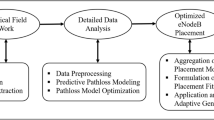Abstract
In this paper, dynamic traffic load is considered to determine optimal location of base station (BS) using evolutionary optimization algorithms. The various parameters such as site coordinates (x, y), transmitting power, height and tilt are taken as design parameters for BS placement. Coverage maximization and cost minimization are considered as two conflicting objectives with inequality constraints such as handover, traffic demand and overlap. RGA and MNSGA-II algorithms are used to solve single objective and multiobjective BS placement problem respectively. A \(2 \times 2\, \text{ km}^{2}\) synthetic test system is discretized as hexagonal cell structure for simulation purposes. Receiving field strength for all service testing points is calculated using simulations and path loss is calculated using Hata model. In dynamic traffic model, both vehicle and pedestrian movements in up and side directions are considered. Dynamic movement is achieved by randomly moving vehicles and pedestrians for a fixed speed in each sample time. The results show that the RGA is able to determine the optimal BS location after considering the dynamic traffic load and satisfying inequality constraints for both coverage maximization and cost objectives. MNSGA-II algorithm gives well distributed pareto-front for the multiobjective BS placement in single simulation run. The simulation results reveal that the proposed dynamic traffic model is suitable for the real world BS placement problem.









Similar content being viewed by others
References
Rappaport, T. S. (2001). Wireless communications principles and practice (2nd ed.). Prentice-Hall: NewJersy.
Hurley, S. (2002). Planning effective cellular mobile radio networks. IEEE Transactions on Vehicle Technology, 51(2), 243–253.
Anderson, H. & McGeehan, J. P. (1994). Optimizing microcell base station locations using simulated annealing techniques. In Proceedings of IEEE 44th vehicular technology conference Stockholm pp. 858–862.
Tutschuka, K., Gerlich, N., & Tran-Gia, P. (1997). An integrated cellular network planning tool. In Proceedings of IEEE 47th vehicle technology conference pp. 765–769.
Roullier-Callaghan, A. (2001). A radio coverage and planning tool. High Frequency Postgraduate Student Colloquium pp. 35–40.
Luna, F., Durillo, J. J., Nebro, A. J., & Alba, E. (2010). Evolutionary algorithms for solving the automatic cell planning problem: A survey. Engineering Optimization, 42(7), 671–690.
Vasquez, M., & Hao, J.-K. (2001). A Heuristic approach for antenna positioning in cellular networks. Journal of Heuristics, 7(5), 443–472.
Caminada, A., Dony, T., Morlier, J. F., Mourniac, S., & Altman, Z. (2002). OaSys: FTR &D UMTS automatic cell planning tool. Proceedings of IEEE antennas and propagation society international symposium pp. 338–341.
Rawnsley, K., & Hurley, S. (2000). Towards automatic cell planning. Proceedings of IEEE 11th personnel indoor and mobile radio communication symposium pp. 1583–1588.
Zimmermann, J., Hons, R., & Muhlenbein, H. (2000). ENCON: An evolutionary algorithm for the antenna placement problem. Journal of Computers and Industrial Engineering, 4(2), 209–226.
Whitaker, M. R., Raisanen, L., & Hurley, S. (2005). The infrastructure efficiency of cellular wireless networks. Journal of Computer Networks, 48(6), 941–959.
Raisanen, L. (2008). A permutation-coded evolutionary strategy for multi-objective GSM network planning. Journal of Heuristics, 14(1), 1–21.
Zonoozi, M. M., & Dassanayake, P. (1997). User mobility modeling and characterization of mobility patterns. Journal of Selected Areas in Communication, 15(7), 1239–1252.
Markoulidakis, J. G., Lyberopoulos, L., Tsirkas, D. F., & Sykas, E. D. (1997). Mobility modeling in third-generation mobile telecommunications systems. Journal of Selected Areas in Communication, 4(4), 41–56.
Wang, W., Cao, Y., Li, D., & Qin, Z (2007). Markov-based hierarchical user mobility model. Wireless and Mobile Communication: Third International Conference p. 47.
Lakshminarasimman, N., Baskar, S., Alphones, A., & Iruthayarajan, M. (2011). Evolutionary multiobjective optimization of cellular base station locations using modified NSGA-II. Journal of Wireless Networks, 17(3), 597–609.
Pujji, L. K., Sowerby, K. W., & Neve, M. J. (2010) Base station placement in multi-floored buildings. 20th Virginia technical symposium on wireless personal communications pp. 1–5.
Hata, M. (1980). Empirical formula for propagation loss in land-mobile radio service. IEEE Transactions on Vehicular Technology, 29(3), 317–325.
Deb, K., & Goel, T. (2001). Evolutionary multi-criterion optimization. Berlin: Springer.
Deb, K., & Agarwal, R. B. (2005). Simulated binary crossover for continuous search space. Complex Systems, 9, 115–148.
Acknowledgments
Authors are grateful to the managements of Thiagarajar College of Engineering, Madurai and K.L.N. College of Engineering, Madurai for having granted permission to utilize their infrastructure facilities for the research activities. Authors are also grateful to Dr. Stephen Hurley, Reader, Department of computer science and Director of the centre of mobile communications, Cardiff University, Wales, UK for his expert guidance. The authors also show their gratitude to Bharat Sanchar Nigam Limited, Madurai for having rendered many useful discussions and providing technical clarifications.
Author information
Authors and Affiliations
Corresponding author
Rights and permissions
About this article
Cite this article
Lakshminarasimman, N., Baskar, S., Alphones, A. et al. Base Station Placement for Dynamic Traffic Load Using Evolutionary Algorithms. Wireless Pers Commun 72, 671–691 (2013). https://doi.org/10.1007/s11277-013-1036-9
Published:
Issue Date:
DOI: https://doi.org/10.1007/s11277-013-1036-9




